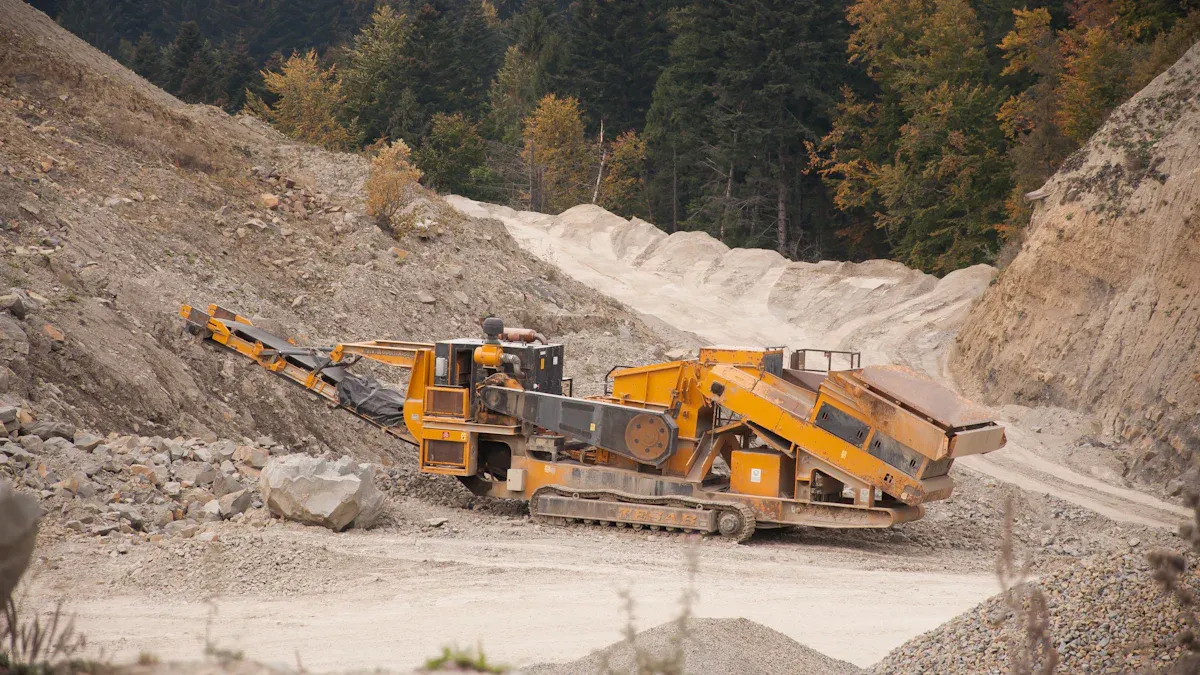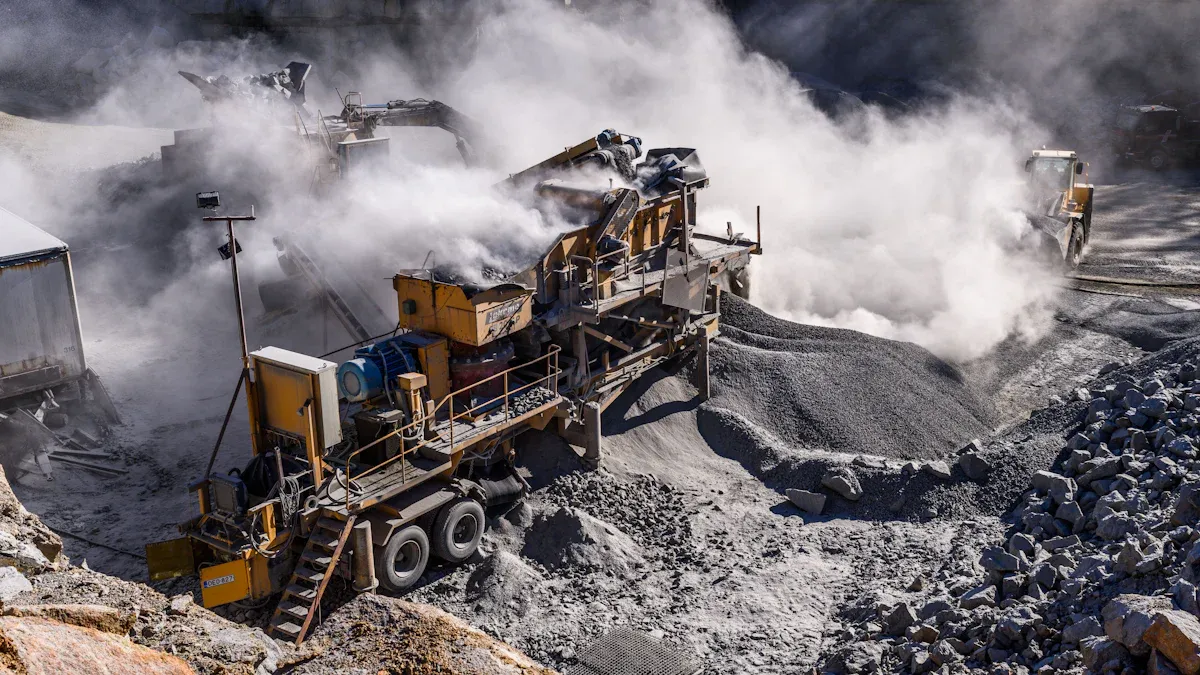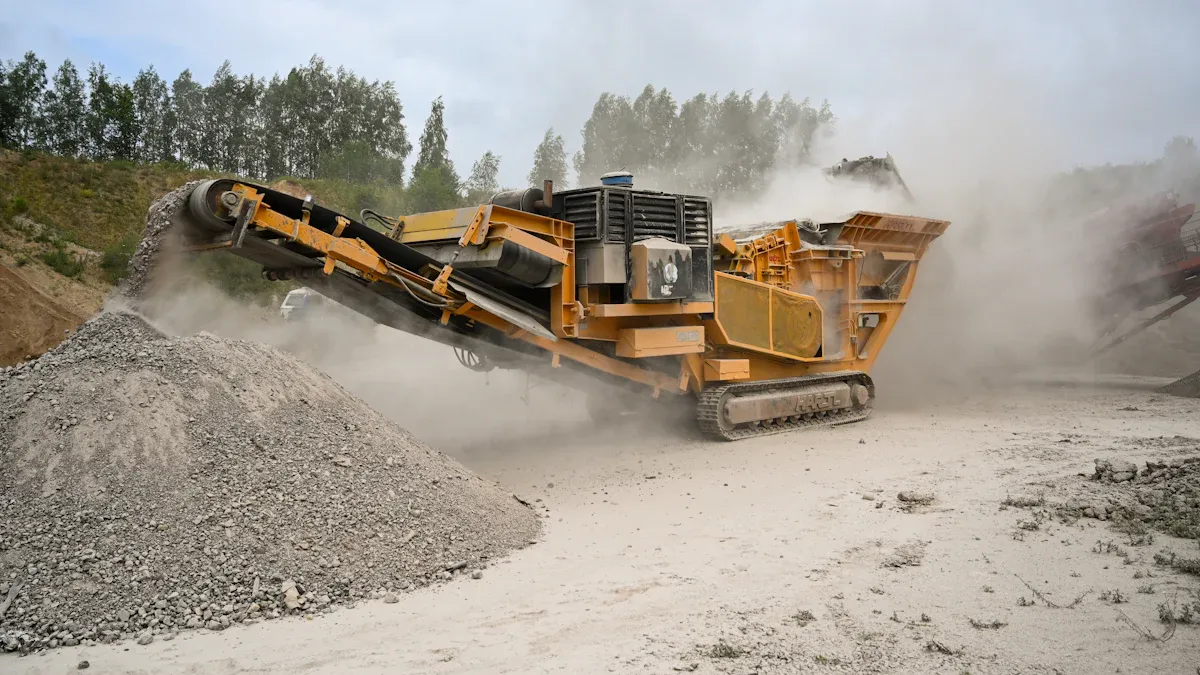
Wear plates in a jaw crusher play a vital role in maintaining efficiency and reducing operational costs. Durable plates ensure consistent ore crushing, minimizing downtime and maximizing output. For example:
Excessive wear can decrease production by 10–20%, costing up to $8,000 daily.
Upgrading to Hardox® 500 doubles wear plate life, cutting maintenance stops by 50%.
By focusing on durability, you can save costs and improve crusher performance significantly.

Jaw plates are essential components of a jaw crusher. They consist of two main parts: the stationary plate and the moving plate, also known as the swing jaw. These plates work together to crush materials by applying immense pressure. The stationary plate remains fixed, while the swing jaw moves back and forth, compressing the material against the stationary plate. This process breaks down large solids into smaller, manageable pieces.
The durability of jaw plates directly impacts the crusher's performance. Made from manganese steel, these plates are designed to withstand high levels of stress and wear. However, their effectiveness depends on factors like material hardness, abrasiveness, and the crusher's operating conditions.
Jaw crusher plates come in different designs to suit various applications. The two primary types are smooth and toothed plates:
Smooth Jaw Plates: These plates have a flat surface, making them ideal for crushing softer materials. They provide consistent performance and produce finer output.
Toothed Jaw Plates: These plates feature a ribbed design, which enhances grip and compression. They are better suited for harder, more abrasive materials.
| Type of Jaw Plate | Description | Performance Characteristics |
|---|---|---|
| Smooth Jaw Plates | Flat and uniform surface for softer materials. | Consistent crushing and finer product output. |
| Toothed Jaw Plates | Ribbed design for harder materials. | Improved grip and compression for tough tasks. |
Choosing the right type of jaw plate depends on the material being crushed and the desired output size. For example, smooth plates work well with limestone, while toothed plates excel in handling quartzite or granite.
Jaw plates face significant wear during operation, which can reduce their lifespan and efficiency. Common issues include:
Abrasion: Materials like quartzite and feldspar cause rapid wear due to their abrasive nature. For instance, jaw crushers processing quartzite in Sweden experienced wear rates three times higher than standard iron ore.
Impact Damage: Repeated crushing of hard materials can lead to cracks or fractures in the plates.
Uneven Wear: Improper alignment or inconsistent feeding can cause one side of the plate to wear faster than the other.
These issues not only shorten the wear life of jaw plates but also increase maintenance costs. For example, a Brazilian limestone quarry reported replacing jaw plates every 6-8 weeks due to excessive wear. Regular inspection and proper material selection can help mitigate these problems.
The material composition of jaw plates significantly affects their wear life and performance. Manganese steel and alloy steel are the two most common materials used for jaw crusher plates. Each offers distinct advantages depending on the application.
| Feature | Manganese Steel Jaw Plates | Alloy Steel Jaw Plates |
|---|---|---|
| Hardness | Medium (Work-hardening) | Higher Initial Hardness |
| Wear Resistance | Increases Over Time | Consistently High |
| Impact Resistance | High (Shock-absorption) | Lower (May Crack Under High Impact) |
| Abrasion Resistance | Good for coarse crushing | Better for fine crushing |
| Best For | Hard, abrasive rocks | Softer materials & fine crushing |
| Lifespan | Medium to Long | Long (If Used in Correct Application) |
| Cost | Lower initial cost | Higher initial cost |
Manganese steel plates excel in primary crushing applications due to their work-hardening properties. They absorb shock well and are cost-effective but may wear quickly initially. Alloy steel plates, on the other hand, offer higher hardness and abrasion resistance, making them ideal for secondary and fine crushing. However, they are less impact-resistant and come with a higher upfront cost.
The design and configuration of a jaw crusher directly influence the wear rates of its jaw plates. Several parameters play a role in determining durability:
Diameter of the Moving Cone: Larger diameters enhance crushing capacity but may increase wear.
Base Angle of the Moving Cone: Optimizing this angle minimizes wear rates.
Rotational Speed: Higher speeds increase crushing force but can accelerate wear on jaw crusher wear parts.
| Configuration Factor | Effect on Work Efficiency |
|---|---|
| Diameter of Moving Cone | Larger diameters enhance capacity but increase wear. |
| Base Angle of Moving Cone | Proper optimization reduces wear rates. |
| Rotational Speed | Impacts crushing force and wear on components. |
Additionally, the type of crushing chamber and the size of crushing elements affect efficiency and wear life. Crushers with optimized designs reduce stress on jaw plates, extending their lifespan and improving overall performance.
Your operational practices play a crucial role in determining the durability of jaw plates. High-quality jaw plates reduce downtime and maintenance costs. Investing in durable jaw crusher wear parts can extend service intervals and improve efficiency.
To maximize wear life, follow these practices:
- Monitor jaw plate wear patterns regularly to maintain crushing efficiency.
- Implement scheduled maintenance plans, including daily checks and monthly reviews.
- Optimize feeding practices to ensure even wear across the plates.
- Use jaw plates suited to the material being crushed to minimize abrasion and impact damage.
Studies show that robust jaw plates can increase crusher lifespan by up to 30% and reduce energy consumption. Regular inspections and adjustments help you avoid uneven wear and costly replacements.

Rotating jaw plates is one of the simplest ways to extend their wear life. When you rotate the plates, you ensure that wear occurs evenly across the surface. Uneven wear often leads to premature failure, reducing the efficiency of your jaw crusher. By rotating the plates at regular intervals, you can maximize their lifespan and maintain consistent crushing performance.
Different types of jaw plates, such as one-piece and two-piece designs, benefit from rotation. The table below highlights the advantages of this practice:
| Type of Jaw Plate | Procedure | Benefits |
|---|---|---|
| One-piece | Rotatable | Even wear distribution |
| Two-piece | Rotatable | Extended wear life and performance |
Rotating jaw plates also minimizes downtime. For example, a mining operation in Australia reported a 25% increase in wear life after implementing a rotation schedule. This simple adjustment can save you time and money while improving the efficiency of your jaw crusher.
Choosing the right jaw crusher plates is critical for durability and performance. High-quality plates are made from materials like manganese steel or alloy steel, which offer excellent resistance to wear and impact. These materials ensure that the plates can handle the stress of crushing hard and abrasive materials.
When selecting jaw plates, consider the type of material you process. For softer materials like limestone, smooth plates work best. For harder materials like granite, toothed plates provide better grip and compression. Always choose plates designed for your specific application to reduce wear and extend their lifespan.
Investing in high-quality jaw crusher wear parts may seem costly upfront, but it pays off in the long run. Durable plates reduce the frequency of replacements, lower maintenance costs, and improve overall crusher performance.
Regular maintenance and inspection are essential for extending the wear life of jaw plates. By monitoring wear patterns and addressing issues early, you can prevent costly damage and downtime.
Here are some maintenance tips to follow:
- Inspect plates daily: Look for signs of uneven wear, cracks, or fractures.
- Clean the crusher regularly: Remove debris and buildup that can accelerate wear.
- Tighten loose components: Ensure all parts are secure to avoid unnecessary stress on the plates.
- Replace worn plates promptly: Delaying replacement can damage other wear parts and reduce efficiency.
A well-maintained jaw crusher operates more efficiently and lasts longer. For instance, a quarry in Canada extended the lifespan of its jaw plates by 30% through regular inspections and timely replacements. By adopting these practices, you can maximize the performance and durability of your jaw crusher plates.
Optimizing your crusher settings can significantly improve the durability of jaw plates and enhance overall performance. Small adjustments to the crusher's configuration can lead to better wear distribution, reduced energy consumption, and longer-lasting jaw crusher plates. Here’s how you can achieve this:
Adjust the Closed Side Setting (CSS):
The closed side setting determines the smallest gap between the stationary and moving jaw plates. A smaller CSS increases the crushing force, which can accelerate wear. By setting the CSS to an optimal level, you can balance crushing efficiency with wear reduction. For example, increasing the CSS slightly for harder materials can reduce stress on the plates and extend their lifespan.
Monitor Feed Size and Distribution:
Uneven or oversized feed can cause localized wear on jaw plates. Ensure that the material entering the crusher is evenly distributed and within the recommended size range. Using a feeder with a grizzly screen can help remove fines and prevent oversized material from entering the crusher. This practice reduces the risk of uneven wear and improves the durability of jaw plates.
Control the Crushing Speed:
The rotational speed of the crusher impacts the crushing force and wear rate. Higher speeds increase the force applied to the jaw plates, which can lead to faster wear. Adjusting the speed to match the material's hardness and abrasiveness can optimize performance and extend the life of the plates.
Regularly Monitor and Adjust Settings:
Crusher settings should not remain static. Regularly monitor wear patterns on the jaw plates and adjust the settings as needed. This proactive approach ensures that the crusher operates efficiently and minimizes unnecessary wear.
The benefits of optimizing crusher settings are well-documented. The table below highlights some of the key advantages:
| Benefit | Description |
|---|---|
| Energy Consumption Reduction | Up to 30% reduction depending on application, leading to lower cost per ton. |
| Wear Parts Longevity | Wear parts can last 2-4 times longer, reducing the frequency of replacements. |
| Production Efficiency | Fewer stops in production and change-outs, enhancing profitability and safety. |
| Ongoing Optimization | Continuous monitoring and improvement of chamber settings to adapt to changing production needs. |
By fine-tuning your crusher settings, you can achieve a balance between performance and durability. These adjustments not only extend the life of jaw crusher plates but also reduce operational costs and improve overall efficiency. Start by evaluating your current settings and making incremental changes to see measurable improvements.
Specialized coatings and surface treatments can significantly improve the durability of jaw plates. These treatments create a protective layer that reduces wear and tear caused by abrasive materials. For example, thermal spray coatings enhance surface hardness, making the plates more resistant to scratches and impacts.
You can also consider using carbide coatings. These coatings provide exceptional resistance to abrasion and high temperatures. They are especially useful when processing hard materials like quartzite or granite. By applying these treatments, you can extend the lifespan of jaw plates and reduce the frequency of replacements.
Another effective option is plasma nitriding. This process diffuses nitrogen into the surface of the jaw plates, increasing their hardness and wear resistance. It also improves the plates' ability to withstand high-stress conditions. With these advanced treatments, you can protect your jaw plates from premature wear and maintain consistent crusher performance.
Using innovative materials for jaw plates can revolutionize their durability and efficiency. Advanced materials like ceramic composites and specialized alloys offer superior wear resistance compared to traditional options.
Ceramic composites reduce plate weight by 15-20% without compromising stiffness. This improvement enhances operational efficiency and reduces energy consumption.
High-manganese steel achieves up to 500-BHN hardness, increasing wear resistance and extending crusher life by 30-40%.
New alloy steels provide up to 50% extra service life in harsh environments, outperforming conventional steels.
These materials not only improve the lifespan of jaw plates but also enhance the overall performance of your jaw crusher. By investing in these advanced options, you can minimize downtime and maximize productivity.
Enhanced jaw plate designs can significantly improve their durability and reduce the risk of failure. Modern engineering techniques, such as 3D printing and finite element (FE) analysis, allow for the creation of optimized designs tailored to specific applications.
| Evidence Description | Findings |
|---|---|
| 3D printed plates based on generative design outperform manual fitting | Enhanced durability and customization in jaw plate designs lead to better fit and reduced risk of damaging vital structures. |
| Verification and optimization of design using FE | Material reinforcement at stress points improved durability, although a design flaw was identified that limited maximum force resistance. |
For example, 3D-printed jaw plates offer better customization and durability. They fit more precisely, reducing the risk of damaging other components. FE analysis helps identify stress points and reinforce them with additional material, improving the plates' ability to withstand high forces.
By adopting these advanced designs, you can prevent issues like worn-out jaw dies and worn out jaw plates. These innovations ensure that your jaw crusher operates efficiently and reliably, even under challenging conditions.
Improving the durability of jaw crusher wear plates directly impacts performance and cost savings. Durable plates reduce downtime, enhance production efficiency, and lower replacement costs. To achieve this, focus on regular maintenance, selecting high-quality materials, and optimizing crusher settings. Advanced solutions like specialized coatings and innovative designs further extend wear life.
| Benefit | Description |
|---|---|
| Extended Wear Life | Rotating jaw plates maximizes wear life, leading to reduced frequency of replacements. |
| Improved Production Efficiency | Properly maintained jaw plates maintain optimal crushing angles, enhancing production output. |
| Cost Savings | Reusing jaw plates reduces costs associated with frequent replacements and enhances sustainability. |
| Sustainability | Reusing components contributes to a more sustainable operation by minimizing waste. |
By adopting these strategies, you can maximize efficiency and ensure your jaw crusher operates at its best.
Manganese steel is the most common choice. It offers excellent durability and work-hardening properties. For specific applications, alloy steel or ceramic composites may provide better performance. Always match the material to your crushing needs.
Inspect jaw plates daily for signs of wear, cracks, or uneven surfaces. Regular checks help you identify issues early, preventing costly damage and downtime. A quick visual inspection can save you significant time and money.
Tip: Use a flashlight to spot hidden cracks or wear patterns during inspections.
Yes, rotating jaw plates ensures even wear across the surface. This practice prevents premature failure and maximizes durability. Schedule rotations based on wear patterns for the best results.
Crusher settings like the closed side setting (CSS) and rotational speed directly affect wear rates. Optimizing these settings reduces stress on the plates and improves their lifespan. Adjust settings based on material hardness and size.
Specialized coatings like carbide or plasma nitriding enhance wear resistance. They reduce abrasion and impact damage, especially for hard materials. While the upfront cost is higher, the extended lifespan often justifies the expense.
Note: Coatings work best when paired with high-quality jaw plates.